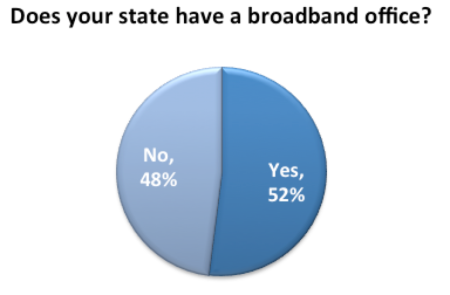Leading Practices for Broadband Offices
Why are broadband offices important? They are a focal point for any questions about broadband, a clearinghouse for information, a staging area for broadband projects, and they provide leadership on broadband issues. They’re critical to driving economic development through broadband.
Through our ongoing work with governments at all levels on broadband issues, which includes the “ Fifty States of Broadband” study, numerous discussions with state broadband offices, as well as regional and national authorities, we would like to share what we would consider “leading practices” for a broadband office.
 First of all… have a broadband office. This seems basic enough, yet in the US only half the states have an office dedicated to broadband. Furthermore, for those that have broadband offices, a number of them are in the state’s IT department. This may seem like a fit on the surface, but strategic broadband efforts need to include more than merely overseeing the technology of broadband. As a driver for economic advancement and improving quality of life, broadband by itself will not reach its potential without a broadband office addressing important needs for driving utilization including training. For example, most businesses – especially small businesses – do not understand how to fully capitalize on the Internet and its applications.
First of all… have a broadband office. This seems basic enough, yet in the US only half the states have an office dedicated to broadband. Furthermore, for those that have broadband offices, a number of them are in the state’s IT department. This may seem like a fit on the surface, but strategic broadband efforts need to include more than merely overseeing the technology of broadband. As a driver for economic advancement and improving quality of life, broadband by itself will not reach its potential without a broadband office addressing important needs for driving utilization including training. For example, most businesses – especially small businesses – do not understand how to fully capitalize on the Internet and its applications.
Broadband is a tool for economic development. A purposeful decision needs to be made so that broadband is managed within a framework policy makers are already familiar. Economic development provides that framework for this critical infrastructure. Additionally, no matter the size of the government entity, the broadband office/evangelist/leader should be a standalone entity, reporting directly to executive branch. Here are some key leading practices we’ve seen from the most effective broadband offices:
Leadership
A broadband office should establish strategies to improve both the availability as well as the utilization of broadband. This includes providing communities with the information, tools, and technical assistance for regional planning – and leadership assistance when requested. Unfortunately most broadband offices are currently stretched thin on resources to drive meaningful use of Internet applications and with it economic growth and improved quality of life.
Information and Resource Center
The best broadband offices serve as evangelists, knowledge centers, and clearinghouses of information. They field and answer questions from legislators, mayors, and local stakeholders. They serve as advisors and help set goals and objectives for their communities, sharing and promoting best practices and advice. If an answer is needed, the broadband office either has it – or will find it.
There is a tremendous opportunity to serve as a resource for citizens, but currently only twenty-seven percent providing digital literacy/technology training and twenty-five percent offering technology training for businesses.
Holistic Broadband Planning
Effective broadband planning cannot stop with simply mapping where broadband is available. Broadband offices need to have the funding and capacity to not only understand where broadband is available, but also to understand where there is active vs. latent vs. potential broadband demand. This will identify where there are gaps in digital inclusion, digital literacy, and technical capability – each of which are barriers to growth and need to be addressed specifically. Capturing data on broadband supply and demand informs smart strategies and drives economic advancement. Investments and action plans need to address both access and meaningful use of broadband – a holistic approach. It is the broadband office’s role to write a statewide plan and hire expertise to fill in the gaps and make the plan a reality. Finally, benefits need to be measured and tracked to ensure that expected benefits will be achieved through appropriate investments.
The fact is there is no ‘one size fits all’ solution for a broadband office. However, each successful broadband office we’ve studied is doing these things. Putting leading practices together with the funding needed is a necessary investment for growth in an economy that is increasingly online.




